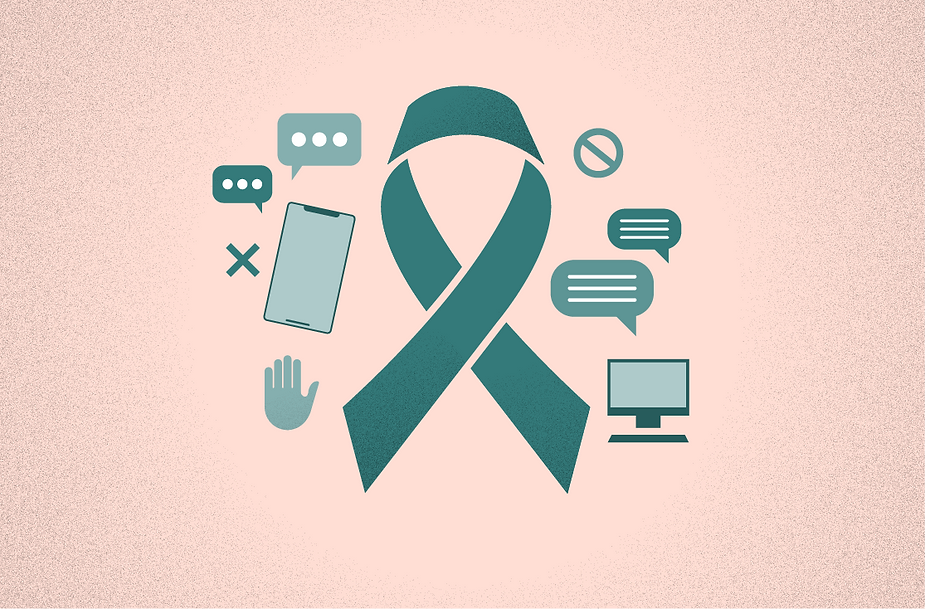This year's Sexual Assault Awareness Month is shedding light on online harassment. Here's how you can make your virtual workspaces safer.
April is Sexual Assault Awareness Month, which was created to raise awareness and prevention of sexual violence, abuse, and harassment, whether it happens verbally, physically, or in online spaces. If you haven’t heard of this particular awareness month before, despite decades of social activism around the issue of sexual assault, an officially-recognized awareness month is relatively new. The Sexual Violence Resource Center first campaigned to have an official month to recognize this in 2001, and President Obama officially declared April to be Sexual Assault Awareness Month in 2009.
This year’s Sexual Assault Awareness Month (SAAM) is campaigning on the message “Building Safe Online Spaces Together.” In the past two years, the Sexual Assault Awareness Month campaign has focused their message on the prevalence of sexual harassment taking place online, with April 2021’s campaign message titled “We Can Build Safe Online Spaces.”
For too long, harassment, cyberbullying, sexual abuse, and exploitation have come to be expected as typical and unavoidable behaviors online. –National Sexual Violence Resource Center.
It’s no surprise to anyone reading this that in 2022, we’re more online than ever, meaning that most of us are no stranger to online toxicity and harassment. While the internet is a useful tool for remote work, socialization, and the spread of information worldwide, approximately two in five Americans have reported experiencing online harassment, and those reporting have noted that online harassment has gotten more severe over time. And no, we’re not here to add to your daily doom-scrolling. Instead, in the spirit of “Building Safe Online Spaces Together,” we’d like to share some of our research, best practices, and resources for dealing with online harassment.
What is Online Harassment?
Online harassment includes, but is not limited to, lewd comments/texts/chats/visuals, aggression, threats of violence, spreading lies, posting sensitive information like contact information or private photos online (also known as doxing), and more.
Why does this matter? In addition to the interpersonal harm, trauma, and decreased work performance that we already know harassment causes, research shows that workplace cyberbullying has been linked to poor health.
What You Can Do
Now that we’ve covered what online harassment can look like in the work environment and who is most at risk, here are some strategies you can implement to prevent, discourage, and discipline online harassment, whatever your job or position.
Maintain decorum and respect, establish the new norms, and set ground rules
If you’re a manager, you may want to pay close attention here, because research shows that people tend to engage in harassment when they feel that the social environment allows it. In the same way that we learn to communicate differently in different online species, it’s important to pay attention to the tone we’re setting in our online workplace. Try setting rules or agreed-upon guidelines as a baseline.
Remember that the informality of online meetings can unintentionally encourage comments or jokes that you’d never say in real life. Sometimes adding a Zoom window can throw our sensors off when it comes to things like commenting on other people’s homes or workspaces. (For example, compliments on background decor are typically okay, but try to avoid saying things like “I don’t see anyone in the background, do you live alone?”)
Always be aware of your camera and mic
Whether your camera and mic are on or off, you should always behave as if they’re on and your coworkers can see and hear you. New Yorker editor Jeffrey Toobin was recently fired after he exposed himself on a Zoom call, in what he claimed was an accident. But there is a difference between intention and impact: what he might have meant to do doesn’t mitigate what coworkers saw and the harm that was caused as a result. Remember that even if you’re not the focus, you are present, potentially visible and audible, and should maintain workplace decorum–even if you’re muting yourself to chow down during a lunch meeting.
Make room for everyone
Online workspaces have different learning curves for everyone, and many of us are still adjusting to the practicalities of working remotely. This can be most important in discussion-based settings like Zoom stand-up calls or discussions in a Slack thread. In distributed teams, it’s important to monitor how all sorts of differences, from gender, to English-language confidence, to the introvert-extrovert spectrum influence how we’re participating in the virtual space. Make room for everyone. For general meeting etiquette, hand-raising (the virtual version of the talking stick) is one of the best ways to make sure everyone can get a word in.
Practice basic online safety and security
Always adhere to internet safety protocols. Use strong passwords or a password manager, limit the personal information you share on public sites, and only open links and files from sources you recognize and trust.
Check your video background
Make sure you know what and who your coworkers can see in the background. Diapered toddlers running in and out of frame are acceptable (and, oftentimes, unstoppable). Grown adults walking around in the same state of undress? Not okay.
Shut it down
Just like in-person harassment, if you witness online harassment, intervene if you feel comfortable, check in with your colleagues to see how you can best support them, and always report harassment to a manager. (Remember that you are free to report after the fact, should you feel more comfortable doing so.) If you’re a manager, make sure that your team knows that engaging in workplace harassment online is still harassment, and that if they experience it, you’re there to help. Shut it down, immediately.
Typing something may feel more casual and depersonalized than saying it IRL, but the impact is often the same. As we continue to build better workplaces, both online and offline, it’s important to stay rigorous, well-researched, and open to feedback from our teams. Little by little, using all the tools we have at our disposal, we’re making progress toward a safer, braver online experience for everyone.
Looking for inclusive training solutions that work well with remote and hybrid teams? Check out Ethena's Courses page for more.








